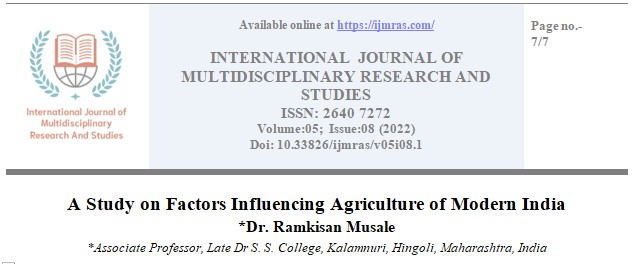A Study on Factors Influencing Agriculture of Modern India .

Abstract
Agriculture is the backbone of the Indian economy. However, it is going through the struggling phase marking sluggish or no growth for several decades. The Indian economy has been shifting its paradigm from core agriculture-based to service-oriented in the last few decades. It is influenced by global trends, market dynamics, government policies, and stakeholder expectations. After signing General Agreement on Tariffs and Trade in 1991, India accepted the ‘Open Door Policy.’ It further led to the major reforms in the Liberalization, Privatization, and Globalization (LPG) model. It positively impacts sectors like information technology, banking, finance, education, e-commerce, retail, insurance, and other service sectors. However, agriculture has remained detached from developments even after 70 years of independence.
Keywords
Agriculture, Rural Economy, Indian Economy, Modern India.How to Cite
References
• Gaikwad, Santosh R. (2016). Linking Entrepreneurship to Education for Futuristic India. International Journal of Economics and Commerce, Vol. 2(3), Pp. 87-90. Maharashtra Economic & Commerce Association.
• GoI-NITI Aayog. (2019). SDG India: Index and Dashboard. https://niti.gov.in/sites/default/files/2019-12/SDG-India-Index-2.0_27-Dec.pdf
• Government of India (Ministry of Agriculture & Farmers Welfare). “State of Indian Agriculture 2015-16.”
• Kadrolkar, Vilas. (2014). “Self-Employment Generation in Rural Economy: A Study of Skill Generation Programme.” Training and Development Journal, Volume-4, Pp. 29-36
• Kaleeshwaran, M. & Rajalakshmi, C. (2015). Contribution of Female Labour in Agriculture: A Case Study of Erode District of Tamil Nadu. International Journal of Scientific and Research Publications, Volume 5, Issue 8. Pp. 1-4
• Kumar, V. and Sinha, K. (2014) Status and Prospect of Research and Development in Agriculture in India. Journal of Science Policy & Governance, Pp. 1-9
• Mathur, A. (2011) “The Dimensions of Indian Rural Development: Issues and Challenges”. International Journal of Contemporary Practices - Vol. 1, Issue. 2. Pp. 29-34.
• Mathur, A. (2011) “The Dimensions of Indian Rural Development: Issues and Challenges”. International Journal of Contemporary Practices - Vol. 1, Issue. 2. Pp: 29-34
• Mundle, S. (2017). Employment, Education and the State. A Working Paper No. 188 Series published by National Institute of Public Finance and Policy, New Delhi.
• Prasad, Chandra S. (2009). “Agriculture and Rural Development in India Since 1947”. New Delhi, India: New Century Publications.
• Singh, Amarjeet and Singh, Jaspal. (2017). Agricultural Scenario and Issues: A study of Punjab and Haryana”, International Journal of Research in Economics and Social Sciences, Vol. 07 (07), pp:- 422-430.
• Swamikannan, D. & Jeyalakshm, C. (2015). Women Labour in Agriculture in India: Some Facets. International Journal of Business and Economics Research, Volume-1(1), Pp. 22-28.
• The India Brand Equity Foundation (IBEF: 2018). A Report on “Agriculture in India: Information About Indian Agriculture & Its Importance.”
• Vasant Gandhi (January 2017). An article on “Agriculture contributes about 14% to India’s economic output, despite nearly half of the country’s population being involved in farm-related activities” was published in the Economic Times.
License
Copyright (c) 2022 Ramkisan Musale

This work is licensed under a Creative Commons Attribution 4.0 International License.
Individual articles are published Open Access under the Creative Commons Licence: CC-BY 4.0.



